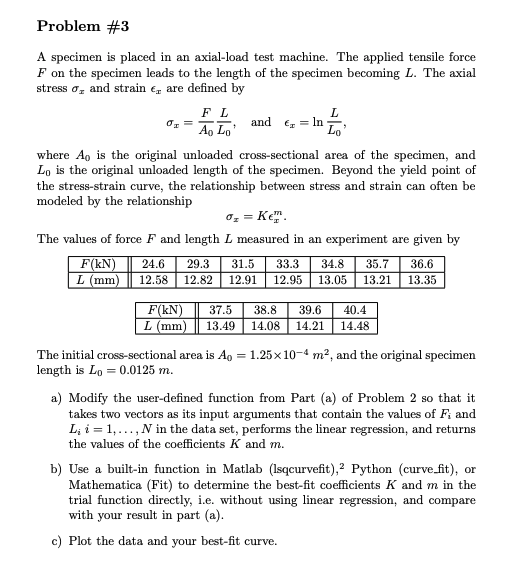Answered step by step
Verified Expert Solution
Question
1 Approved Answer
Please answer parts needing code in Python Problem #3 A specimen is placed in an axial-load test machine. The applied tensile force F on the

Please answer parts needing code in Python
Problem #3 A specimen is placed in an axial-load test machine. The applied tensile force F on the specimen leads to the length of the specimen becoming L. The axial stress og and straine, are defined by 0,- E and = In = where Ao is the original unloaded cross-sectional area of the specimen, and Lo is the original unloaded length of the specimen. Beyond the yield point of the stress-strain curve, the relationship between stress and strain can often be modeled by the relationship 0,= Ke! The values of force F and length L measured in an experiment are given by F(kN) 24.6 29.3 31.5 33.3 34.8 35. 7 36.6 L (mm) || 12.58 12.82 12.91 | 12.95 13.05 13.21 | 13.35 F(kN) || 37.5 L (mm) 13.49 38.8 14.08 39.6 14.21 40.4 14.48 The initial cross-sectional area is A0 = 1.25 x 10-4 m2, and the original specimen length is Lo = 0.0125 m. a) Modify the user-defined function from Part (a) of Problem 2 so that it takes two vectors as its input arguments that contain the values of F, and Lii= 1,..., N in the data set, performs the linear regression, and returns the values of the coefficients K and m. b) Use a built-in function in Matlab (Isqcurvefit),? Python (curve.fit), or Mathematica (Fit) to determine the best-fit coefficients K and m in the trial function directly, i.e. without using linear regression, and compare with your result in part (a). c) Plot the data and your best-fit curve. Problem #3 A specimen is placed in an axial-load test machine. The applied tensile force F on the specimen leads to the length of the specimen becoming L. The axial stress og and straine, are defined by 0,- E and = In = where Ao is the original unloaded cross-sectional area of the specimen, and Lo is the original unloaded length of the specimen. Beyond the yield point of the stress-strain curve, the relationship between stress and strain can often be modeled by the relationship 0,= Ke! The values of force F and length L measured in an experiment are given by F(kN) 24.6 29.3 31.5 33.3 34.8 35. 7 36.6 L (mm) || 12.58 12.82 12.91 | 12.95 13.05 13.21 | 13.35 F(kN) || 37.5 L (mm) 13.49 38.8 14.08 39.6 14.21 40.4 14.48 The initial cross-sectional area is A0 = 1.25 x 10-4 m2, and the original specimen length is Lo = 0.0125 m. a) Modify the user-defined function from Part (a) of Problem 2 so that it takes two vectors as its input arguments that contain the values of F, and Lii= 1,..., N in the data set, performs the linear regression, and returns the values of the coefficients K and m. b) Use a built-in function in Matlab (Isqcurvefit),? Python (curve.fit), or Mathematica (Fit) to determine the best-fit coefficients K and m in the trial function directly, i.e. without using linear regression, and compare with your result in part (a). c) Plot the data and your best-fit curveStep by Step Solution
There are 3 Steps involved in it
Step: 1

Get Instant Access to Expert-Tailored Solutions
See step-by-step solutions with expert insights and AI powered tools for academic success
Step: 2

Step: 3

Ace Your Homework with AI
Get the answers you need in no time with our AI-driven, step-by-step assistance
Get Started


